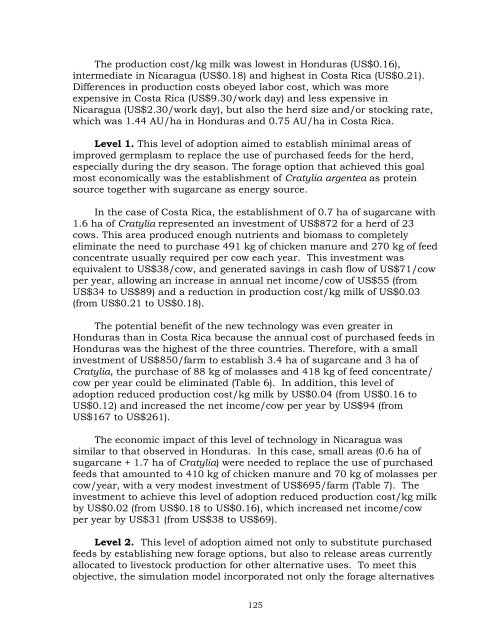Feeding Systems with Legumes to Intensify Dairy Farms - cgiar
Feeding Systems with Legumes to Intensify Dairy Farms - cgiar
Feeding Systems with Legumes to Intensify Dairy Farms - cgiar
You also want an ePaper? Increase the reach of your titles
YUMPU automatically turns print PDFs into web optimized ePapers that Google loves.
The production cost/kg milk was lowest in Honduras (US$0.16),<br />
intermediate in Nicaragua (US$0.18) and highest in Costa Rica (US$0.21).<br />
Differences in production costs obeyed labor cost, which was more<br />
expensive in Costa Rica (US$9.30/work day) and less expensive in<br />
Nicaragua (US$2.30/work day), but also the herd size and/or s<strong>to</strong>cking rate,<br />
which was 1.44 AU/ha in Honduras and 0.75 AU/ha in Costa Rica.<br />
Level 1. This level of adoption aimed <strong>to</strong> establish minimal areas of<br />
improved germplasm <strong>to</strong> replace the use of purchased feeds for the herd,<br />
especially during the dry season. The forage option that achieved this goal<br />
most economically was the establishment of Cratylia argentea as protein<br />
source <strong>to</strong>gether <strong>with</strong> sugarcane as energy source.<br />
In the case of Costa Rica, the establishment of 0.7 ha of sugarcane <strong>with</strong><br />
1.6 ha of Cratylia represented an investment of US$872 for a herd of 23<br />
cows. This area produced enough nutrients and biomass <strong>to</strong> completely<br />
eliminate the need <strong>to</strong> purchase 491 kg of chicken manure and 270 kg of feed<br />
concentrate usually required per cow each year. This investment was<br />
equivalent <strong>to</strong> US$38/cow, and generated savings in cash flow of US$71/cow<br />
per year, allowing an increase in annual net income/cow of US$55 (from<br />
US$34 <strong>to</strong> US$89) and a reduction in production cost/kg milk of US$0.03<br />
(from US$0.21 <strong>to</strong> US$0.18).<br />
The potential benefit of the new technology was even greater in<br />
Honduras than in Costa Rica because the annual cost of purchased feeds in<br />
Honduras was the highest of the three countries. Therefore, <strong>with</strong> a small<br />
investment of US$850/farm <strong>to</strong> establish 3.4 ha of sugarcane and 3 ha of<br />
Cratylia, the purchase of 88 kg of molasses and 418 kg of feed concentrate/<br />
cow per year could be eliminated (Table 6). In addition, this level of<br />
adoption reduced production cost/kg milk by US$0.04 (from US$0.16 <strong>to</strong><br />
US$0.12) and increased the net income/cow per year by US$94 (from<br />
US$167 <strong>to</strong> US$261).<br />
The economic impact of this level of technology in Nicaragua was<br />
similar <strong>to</strong> that observed in Honduras. In this case, small areas (0.6 ha of<br />
sugarcane + 1.7 ha of Cratylia) were needed <strong>to</strong> replace the use of purchased<br />
feeds that amounted <strong>to</strong> 410 kg of chicken manure and 70 kg of molasses per<br />
cow/year, <strong>with</strong> a very modest investment of US$695/farm (Table 7). The<br />
investment <strong>to</strong> achieve this level of adoption reduced production cost/kg milk<br />
by US$0.02 (from US$0.18 <strong>to</strong> US$0.16), which increased net income/cow<br />
per year by US$31 (from US$38 <strong>to</strong> US$69).<br />
Level 2. This level of adoption aimed not only <strong>to</strong> substitute purchased<br />
feeds by establishing new forage options, but also <strong>to</strong> release areas currently<br />
allocated <strong>to</strong> lives<strong>to</strong>ck production for other alternative uses. To meet this<br />
objective, the simulation model incorporated not only the forage alternatives<br />
125
















